1, What is Impressionism?
Impressionism describes a style of painting developed in France during the mid-to-late 19th century; characterizations of the style include small, visible brushstrokes that offer the bare impression of form, unblended color and an emphasis on the accurate depiction of natural light. The founding Impressionist artists – including Claude Monet, Camille Pissarro, Alfred Sisley and Edgar Degas, among others – were united by their desire to cast off the strict rules of academic-style painting. In particular, the artists sought independence from the Académie des Beaux-Arts and its annual Salon (which was, at the time, considered the greatest art show in the Western world).
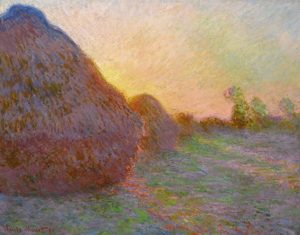
Claude Monet ‘Meules’ 1890 Oil on canvas; Sold for $110.7 million in 2019.
The term “Impressionism” was not chosen by the artists – rather, it was born from a satirical review written by French art critic Louis Leroy (1812 – 1885) in an article on the inaugural exhibition of the Société Anonyme Coopérative des Artistes Peintres, Sculpteurs, Graveurs (‘Cooperative and Anonymous Association of Painters, Sculptors and Engravers’). Held in the spring of 1874, the exhibition included works from 30 Impressionist artists, and is considered the formal start to the movement. In his review, Leroy poked fun at Monet’s 1872 painting Impression, Sunrise, writing that: “‘A preliminary drawing for a wallpaper pattern is more finished than this seascape.
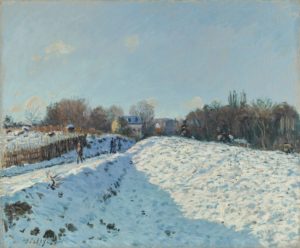
Alfred Sisley ‘Effet de Neige à Louveciennes’ 1874; Sold for $7.3 million in 2017.
Impressionism is often termed the first modern movement in painting, in part because the greater tide of modernization created the conditions which inspired the movement. The industrial revolution and the invention of the railroad suddenly awarded greater leisure time to middle and lower-class Parisians, and a way to travel quickly and inexpensively to the countryside. During this time, circa 1860, four young art students – Monet, Sisley, Pierre-Auguste Renoir and Frédéric Bazille – met while studying under French academic artist Charles Gleyre. In their free time, the students began boarding trains bound for remote areas around the city, where they’d set their easels amongst the fields or riverbanks and try their best to capture the fleeting glints of sunlight reflected by water, workers bent to their task or Parisians enjoying a lazy Sunday by the sea.
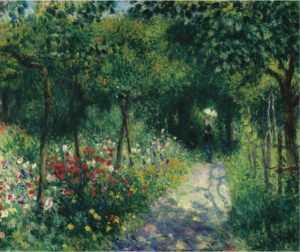
Pierre–Auguste Renoir ‘Femmes dans un jardin’ 1873; Sold for $12.2 million in 2007.
2, Characteristics and Style of Impressionism
There was no one unifying Impressionist style, but the artists associated with Impressionism did share similar modern approaches to painting. Rather than be confined to a studio, many Impressionists preferred to paint en plein air in the countryside outside of Paris; this approach required the artists to work quickly but allowed them to capture the fleeting impressions of light. The artists used short, visible dabs of paint to capture the overall impression of their subject, choosing not to pay particular attention to the fine details. Instead of using black and gray paint to depict shadows, the painters paired complementary colors. The paints themselves were also brighter than those used in previous eras, due to the invention of synthetic pigments. The artists applied new layers of paint over layers that were still wet, which softened the forms and supplied a unique intermingling of colors. The layers were rarely transparent – instead, the application added opaque dimensions of color.
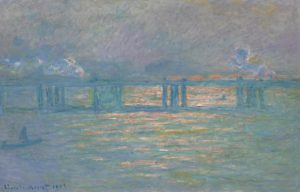
Claude Monet ‘Charing Cross Bridge’ 1903; Sold for $27.6 million in 2019.
3, Japanese Influence
While the content of Impressionist paintings was not all that radical, the composition was. The boundary between figures and background were blurred, making the figures a part of an overall view rather than the main subject, and the figures appeared to be captured in a single moment – as a snapshot – rather than posed. This new approach coincided with the advent of photography and drew inspiration from Japanese style ukiyo-e art prints.
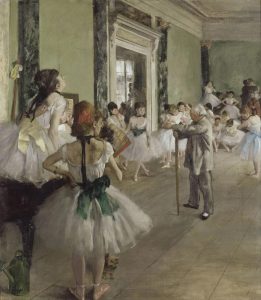
Edgar Degas ‘La Classe de Danse’ c. 1873–76
The ukiyo-e style used foreshortening (angling an object toward a viewer to change the allusion of three-dimensional perspective on a two-dimensional surface) asymmetry to invoke movement and action within a scene. For the Impressionist artists, this technique from the East was a crucial tool in their exploration of a new, modern painting style.
4, Legacy of Impressionism
In the Western world, reactions, criticism and reinterpretations of Impressionism inspired many of the subsequent Modern art movements.
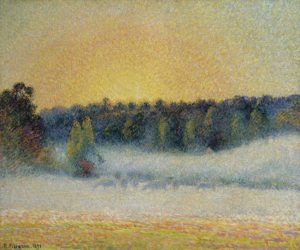
Camille Pissarro ‘Prairie avec vaches, brume, soleil couchant à éragny’ 1891; Sold for $3.7 million in 2018.
The ethos of Impressionism made an enduring impact on music and literature as well as the visual arts. Musical Impressionism involved creating the impression of atmosphere or mood and became popular in France in the late 19th century. French writers and poets, in turn, represented Impressionism with syntactic variation and fragmentary prose.
Today, works by Impressionist artists retain incredible value in the market, founded on unbridled interest among private collectors and the public institutions. In 2019, Sotheby’s sold Monet’s Meules for $110.8 million, setting a new record for the artist; the same year saw retrospectives at Paris’s Musée d’Orsay of works by Berthe Morisot, a leading female Impressionist.
Works by Impressionist artists can be found in numerous public institutions around the world, including the Musée Marmottan Monet, Paris; the Metropolitan Museum of Art, New York; the National Gallery, London; the Musée d’Orsay, Paris; the Museum of Fine Arts, Boston; and the State Hermitage Museum, St. Petersburg.
Source: Sotheby’s







